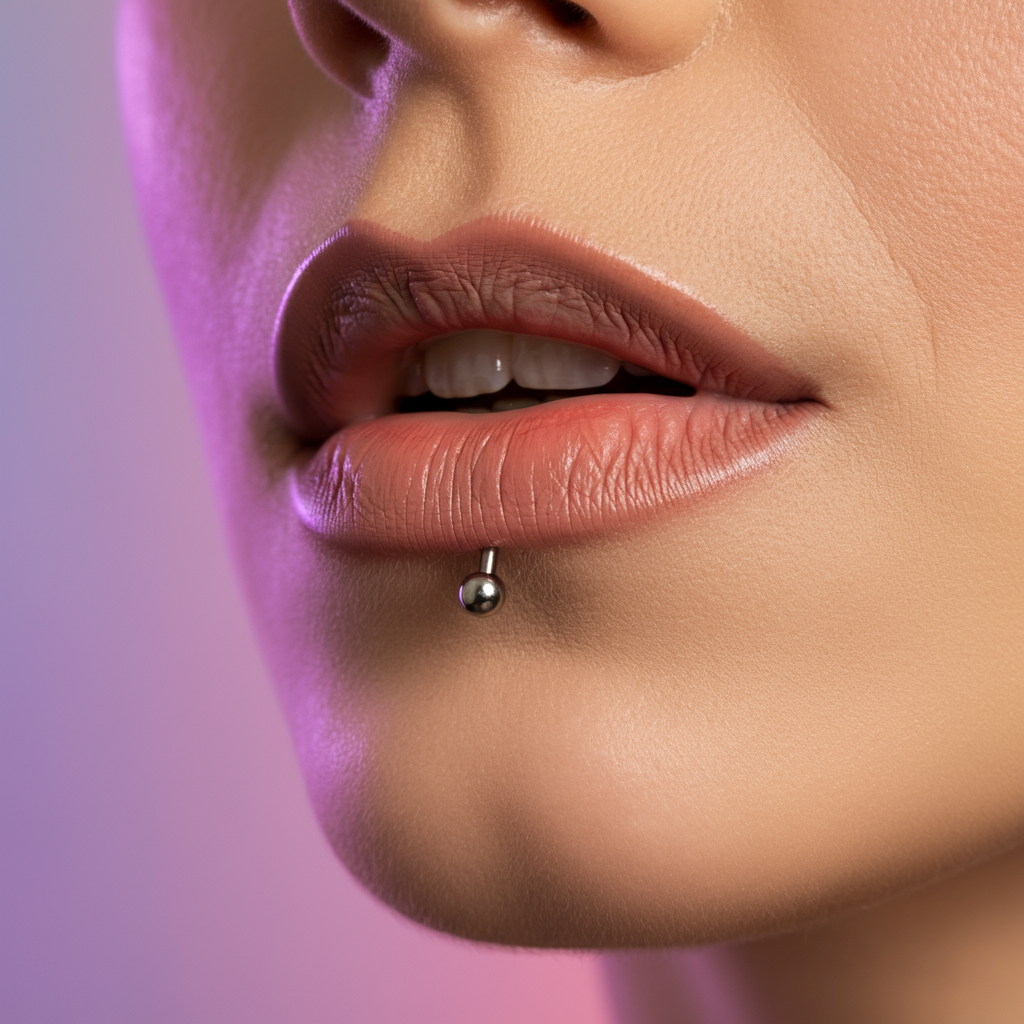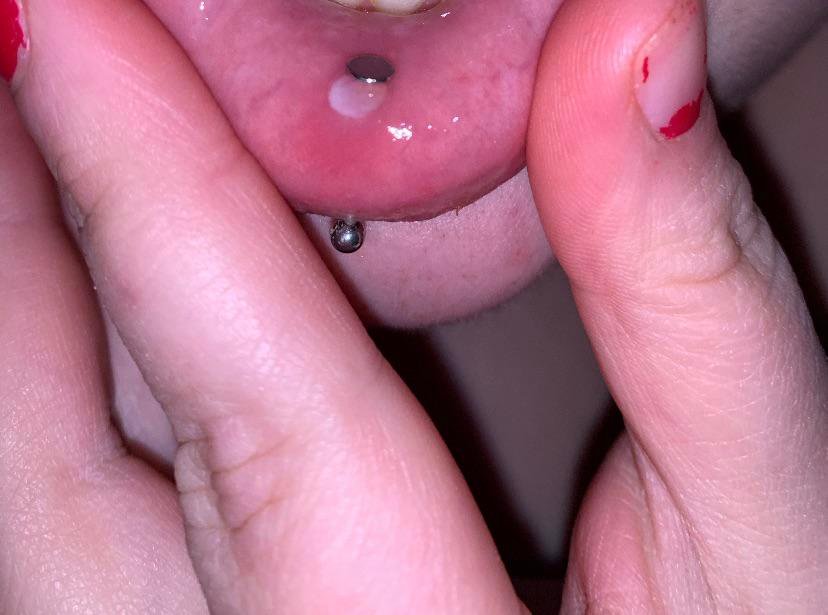A stylish and unique piercing that’s a great way to highlight your lips!
Body modification trends are constantly changing, and the Ashley piercings is one of the most eye-catching right now. Its unique placement, highlighting the lips, is becoming popular among piercing enthusiasts and first-timers. Thinking about getting one or just curious? This blog will cover! We’ll walk you through everything—from the procedure and aftercare to jewellery ideas and potential risks.
What is an Ashley Piercings?

Definition and Placement
The Ashley piercings is a stylish and unique lip piercing that goes vertically through the centre of your lower lip. The entry point is outside your lip, while the exit is inside your mouth. What makes it stand out is the single bead that sits visibly on your lower lip, giving it a bold yet elegant look.
How It Differs from Other Lip Piercings
Unlike a standard labret piercing, which comes out below the lip, or a vertical labret piercing with two visible ends, the Ashley piercings stands out thanks to its unique central placement. Its clean, minimalist look is perfect if you want something subtle but eye-catching.
Why It’s Trending
The Ashley piercings is popular for its unique and versatile style. With 2025 trends leaning into minimalist and delicate jewellery, more people are choosing subtle gems and sleek designs to highlight the Ashley piercings’ clean and classy look.
The Piercing Procedure
Step 1: Consultation and Preparation
Before getting Ashley piercings, you’ll chat with your piercer to talk about placement and make sure your lips are a good fit for the piercing. They’ll carefully mark the entry and exit points to ensure everything is symmetrical and perfectly positioned.
Step 2: Sterilisation and Tools
Using sterile, single-use equipment is key to keeping techniques safe and hygienic. For the Ashley piercings, a hollow needle—usually a 14 or 16 gauge—is the primary tool used to get the job done.
Step 3: The Procedure
The Ashley piercings might use a clamp to keep your lip steady. Then, in one smooth motion, they’ll push the needle through the marked spot on your lower lip from the outside to the inside, quickly followed by placing the jewellery.
Ashley Piercings Pain Level
As my experience goes, it feels like a quick, sharp pinch—nothing too serious! Everyone’s pain tolerance is different, but the whole thing is over in just a few seconds, and any discomfort fades pretty quickly afterwards.
Jewellery for Initial Ashley Piercings
For your first Ashley piercings, I will recommend you to using implant-grade titanium or surgical steel labret studs. These things are great for reducing the risk of allergic reactions or infection. The jewellery will also be sized with a little extra length to allow for any initial swelling.

Aftercare and Healing Process
Immediate Aftercare (First Few Days)
Got your new Ashley piercings? Here’s how to take care of it so it heals perfectly:
- Gently clean the outside with saline solution twice a day.
- Rinse your mouth with alcohol-free mouthwash after eating or drinking.
- Keep your hands clean—don’t touch the piercing with unwashed hands.
- If it swells, a cold compress can help soothe it.
Take it easy, and your piercing will be as good as new in no time!
Long-Term Aftercare (Weeks to Months)
- Keep your piercing clean by using saline solution regularly.
- Take your time while eating to avoid irritating the new piercing.
- Healing Timeline jewellery. The Ashley piercing typically takes 6-12 weeks to heal fully, though healing time can vary from person to person. Makeup, lip products, or any harsh chemicals around the piercing.
- Stay cautious with activities that might snag or pull on your jewellery.
Healing Timeline jewellery. The Ashley piercings typically takes 6-12 weeks to heal fully, though healing time can vary from person to person.
Signs of Proper Healing
Once your Ashley piercing is fully healed, it should feel great—no pain, redness, swelling, or discharge. If anything seems off, don’t hesitate to contact your piercer or a medical professional for advice!
What to Avoid During Healing
- Avoid alcohol and tobacco—they can slow down the healing process.
- Stay away from swimming in pools or open water to keep bacteria away from your piercing.
- Try not to touch or rotate the jewellery unless necessary.
Jewellery Options for Ashley Piercings
Jewelry Styles
Once your Ashley piercing is fully healed, you can have some fun personalising it with a variety of jewellery styles, such as:
- Labret Studs with flat disc backings are designed to be super comfy for everyday wear while minimising irritation.
- Gems or Stones to bring a little sparkle to your day, whether you prefer a subtle shimmer or a bold, eye-catching look.
- Elegant Metal Finishes in gorgeous options like gold, rose gold, or black titanium, perfect for adding a touch of style and sophistication to your vibe.
Sizing and Gauge for Ashley Piercings
The Ashley piercing is usually done with a 14G or 16G needle. Jewellery sizes can vary depending on your anatomy, but it’s super important to pick a post length that fits just right and snug but does not put any pressure on your lip.
Considerations for Oral Health
To keep your gums and teeth happy and healthy, it’s a good idea to choose jewellery made from biocompatible materials like implant-grade titanium or surgical steel. Allergies or discomfort are less likely to result from these materials. Also, steer clear of oversized or poorly fitted jewellery—it can rub against your gums or teeth, causing irritation, enamel damage, or even gum recession over time. By picking high-quality materials and the right fit, you can protect your oral health and show off your style safely!
Potential Risks and How to Avoid Them in Ashley Piercings
Common Risks
Infection: Keep an eye out for signs like excessive redness, swelling, ongoing pain, warmth around the area, or any pus. This could be a sign of infection beginning, so it is important to address this quickly to avoid complications. If you find these signs, contacting a professional doctor for the proper treatment is a good idea.

Jewellery Embedding or Rejection: Sometimes, jewellery can get stuck in the skin, often because of swelling or if it’s too tight, leading to discomfort or irritation.
Migration: Sometimes, piercings can shift a bit from their original spot over time. This might happen due to things like pressure, movement, or your body not fully accepting the jewellery. It could lead to the piercing moving closer to the skin’s surface or settling in a slightly different position.
Oral Health Concerns: Choosing the wrong type of jewellery can lead to some oral health issues, like gum recession (when your gums pull back from your teeth) and enamel wear (which can weaken the protective layer of your teeth). This might cause sensitivity or even increase the risk of cavities, so it’s important to make careful choices!
How to Reduce Risks in Ashley Piercings
- Choose a professional piercer Person who has experience with Ashley piercings and knows the techniques needed for this unique style. Check out their reviews and track record to make sure you’re in safe, skilled hands.
- Stick to a good aftercare routine to help your piercing heal properly and look great for the long run. Keep the area clean, avoid strenuous activities, and use the products your piercer recommends.
- Make sure your jewellery is made from high-quality, skin-friendly materials. It should be durable, comfortable, and safe for sensitive skin so you can enjoy your piercing without any worries.
- Don’t hesitate to contact your piercer if you notice anything unusual, like extra redness, swelling, pain, or discharge, or think your piercing might be infected. He will guide you on the following steps to keep your piercing healthy and healing.
Choosing the Right Piercer
What to Look for in a Piercer
- Make sure they have the proper certifications and licenses.
- Look for experience with lip piercings, especially the Ashley piercing.
- Check out their reviews and reputation in the community.
- Choose a clean, sterile studio that really prioritises hygiene.
It’s a good idea to book a consultation beforehand to get a sense of the studio and the piercer’s skills!

Recap & Final Considerations
Ashley piercing is a simple but attractive way to add a unique touch to your look. Whether it’s about getting the placement right, keeping up with safe aftercare, or picking the perfect jewellery, every step matters to ensure your piercing turns out stylish and hassle-free.
Thinking about getting an Ashley piercing? Take time to find an experienced piercer, stay on top of aftercare, and go for high-quality jewellery to avoid any issues. You may show your individual style while having this classy piercing if you take proper care of it!
FAQs
Q1. How much does an Ashley piercing hurt?
The pain level is subjective and varies from person to person based on individual pain tolerance. However, most people report the pain as being moderate, often described as a quick pinch, rating it around a 3 to 6 out of 10. The initial piercing pain subsides quickly, leaving behind some tenderness and swelling. Some individuals compare the pain to other lip piercings or even ear cartilage piercings
Q2. How long does an Ashley piercing take to heal?
The typical healing time for an Ashley piercing is around 2 to 4 months. However, it can sometimes take longer depending on individual healing abilities and aftercare practices. It’s crucial to be patient and continue aftercare diligently even if the piercing appears healed on the outside. Consulting a piercer to confirm complete healing is always recommended.
Q3. What type of jewelry is used for an Ashley piercing?
Typically, a flat-back labret stud made of implant-grade stainless steel or titanium is used for Ashley piercings. The flat back sits comfortably against the inside of the lip, reducing the risk of irritation to the gums and teeth. Initially, a longer bar is used to accommodate swelling, and once the swelling subsides (usually after a few weeks), it’s essential to downsize to a shorter bar for a more comfortable and secure fit, minimizing the risk of oral damage. The visible end on the outside of the lip can be a bead, gem, or other decorative piece.
Q4. Can an Ashley piercing affect my teeth?
Yes, an Ashley piercing can affect your teeth and gums if proper precautions are not taken. The back of the jewelry sits inside the mouth and can potentially rub against the teeth and gums. To minimize this risk:
- Downsize Jewelry: Ensure you downsize to a shorter labret bar once the initial swelling has gone down.
- Proper Placement: A skilled piercer will aim for placement that minimizes contact with teeth and gums.
- Avoid Playing with Jewelry: Refrain from clicking or biting on the jewelry.
- Good Oral Hygiene: Maintain excellent oral hygiene to prevent any issues.
- Regular Check-ups: Monitor your teeth and gums for any signs of irritation or damage and consult your dentist if you have concerns.
Q5. Can I hide an Ashley piercing?
While the jewelry on the outside of the lip is visible, it can be somewhat concealed by closing your mouth. Depending on the size and style of the jewelry, it might also be partially hidden with makeup like lipstick once the piercing is fully healed.


